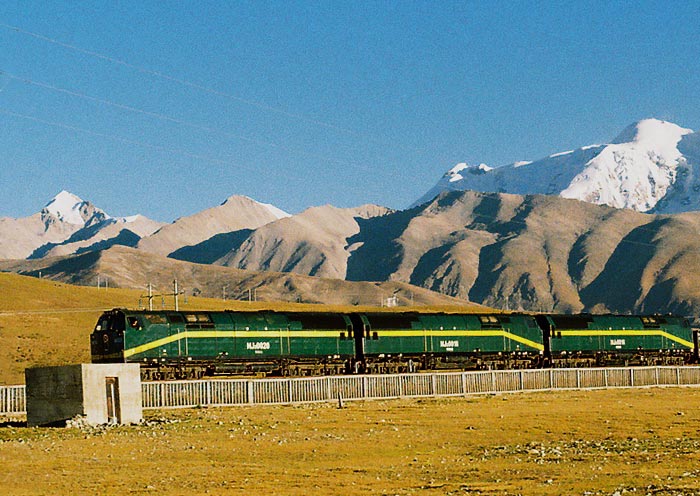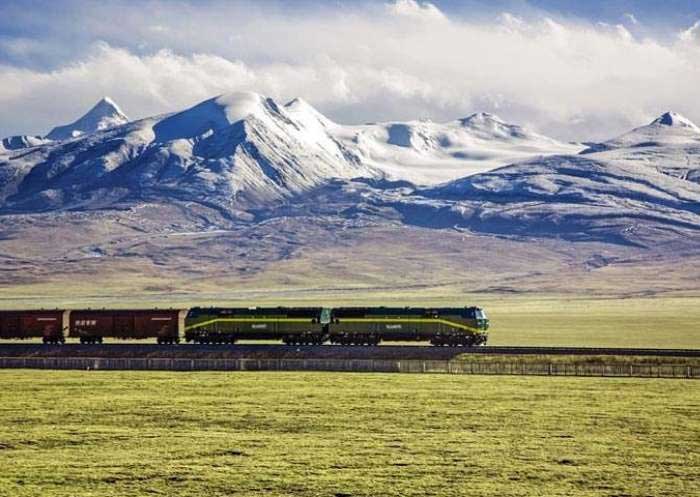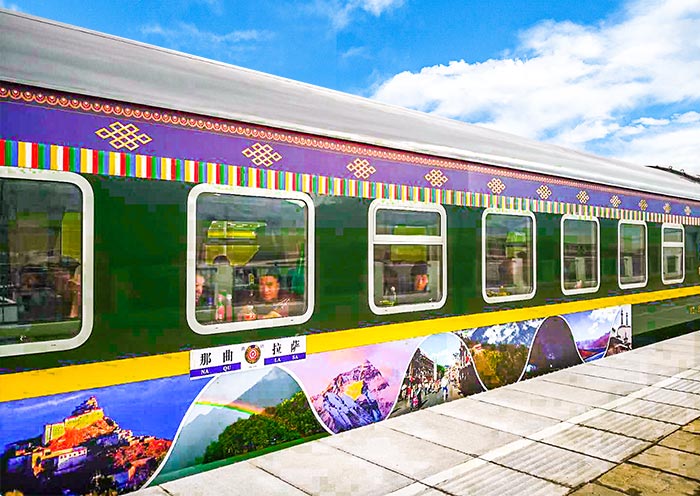Qinghai Tibet Railway Facts, World Records & Altitude
Length: The total length of the Qinghai-Tibet Railway is 1,956 kilometers.
Route: The railway runs from Xining to Lhasa.
Opening: The railway was opened in 2006.
Duration: The journey on this railway takes approximately 20 hours.
Main Stations: Xining, Delingha, Golmud, Amdo, Nagqu, Lhasa
Highlights: Qinghai Lake, Mt. Yuzhu, Hoh Xil, Tuotuo River, Cona Lake, The Northern Tibetan Plateau, Nyenchen Tanglha Mountains
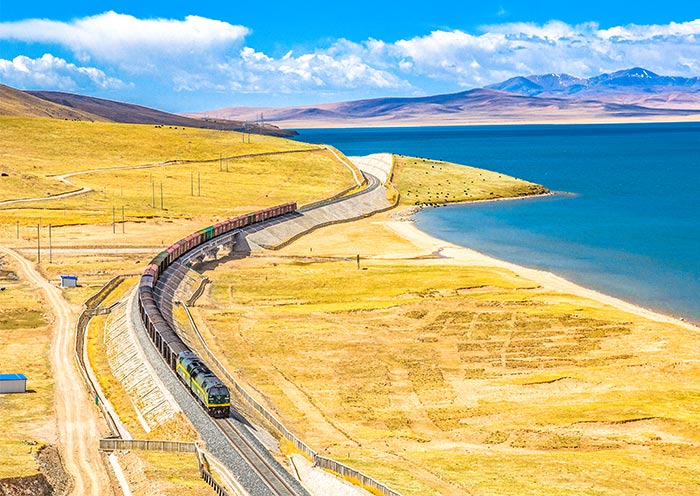

Qinghai Tibet Railway: 9 World Records
1. Longest Plateau Railway: Spans a staggering 1,956 kilometers, earning it the title of the longest plateau railway globally.
2. Highest Altitude Railway: A remarkable section of the railway, stretching over 960 kilometers from Golmud to Lhasa, traverses land with an altitude exceeding 4,000 meters.
3. Fastest Plateau Railway: It outruns all competition, with trains achieving velocities of 100 km/h, setting the rec ord for the fastest plateau railway.
4. Longest Permafrost Railway: It includes a 600-kilometer stretch built on permafrost, the longest of its kind.
5. Highest Railway Station: The Tanggula Pass station, perched at an altitude of 5,068 meters, is the highest railway station in the world.
6. Longest High-Altitude Permafrost Tunnel: The Kunlun Mountain Tunnel, with a length of 1,686 meters, holds the record for the longest high-altitude permafrost tunnel.
7. Highest Track-Laying Base: The track-laying base in Amdo County is the highest in the world, at an altitude of 4,704 meters.
8. Longest Permafrost Railway Bridge: The Qingshui River Bridge, which spans 11,700 meters (7.27 miles) across the southern Kunlun Mountains and the edge of Hoh Xil, is the longest bridge built on permafrost.
9. Highest Permafrost Tunnel: The Fenghuoshan Tunnel, at an altitude of 5,010 meters (16,437 feet), is the highest permafrost tunnel in the world.
Qinghai-Tibet Railway Altitude
The average altitude of the Qinghai-Tibet Railway is above 4,000 meters. The elevation from Xining to Golmud is around 3,000 meters. From Golmud, the altitude starts to climb until reaching the highest point, Tanggula Pass, at 5,068 meters. The subsequent altitudes remain around 4,000 meters until reaching Lhasa at an altitude of 3,650 meters.
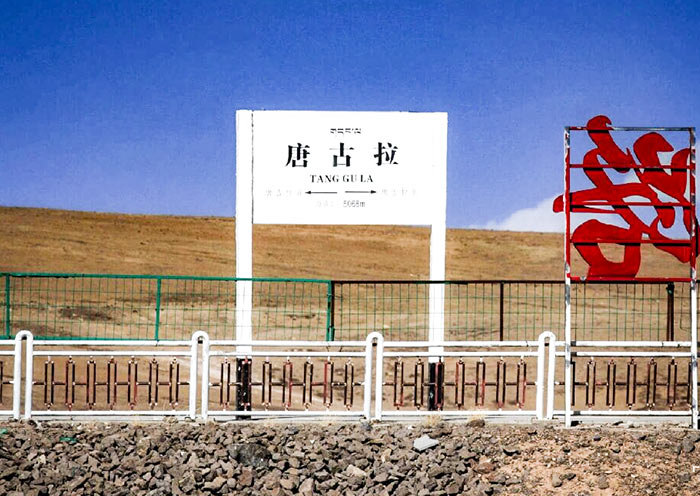
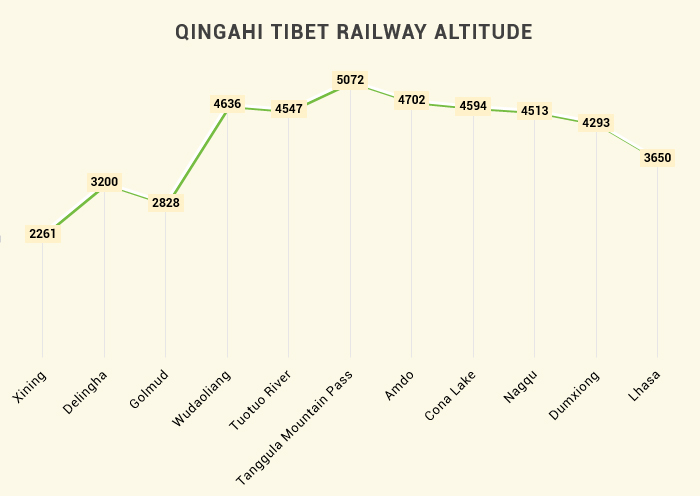
Qinghai Tibet Railway Construction - Engineering Marvel
The construction of the Qinghai-Tibet Railway is considered a remarkable engineering feat as it was built under harsh and challenging conditions.
Qinghai Tibet Railway History: Construction Phases
Xining to Golmud (1974 - 1984): The first phase of the railroad was approximately 814 miles (1,310 km) long and was completed in 1984. This phase was less challenging than the second due to the relatively flat terrain and lower elevation.
Golmud to Lhasa (2001-2006): The second phase of the project was approximately 1,142 kilometers long and was completed in 2006. This phase was particularly challenging due to the high altitude, permafrost conditions and low oxygen levels.
Engineering Challenges
High Altitude: Most of the railroad was constructed at an altitude of 4,000 meters above sea level, with the highest point, the Tanggula Pass, at 5,072 meters. The high altitude and low oxygen content posed serious health risks to the construction crews and affected the performance of the construction machinery.
Permafrost: A large portion of the railroad is located on permafrost terrain. When the ground thaws and freezes, it can lead to ground instability. Engineers addressed this issue by building elevated tracks with pile structures and using thermosiphons to prevent the ground from thawing.
Environmental Concerns: The railroad crosses the Tibetan Plateau, home to a variety of endangered species and fragile ecosystems. The impact on animals was minimized by building animal migration corridors and using environmentally friendly construction techniques.
Qinghai Tibet Railway Map & Route
The Qinghai-Tibet Railway, an engineering marvel and a lifeline for remote Tibetan regions, forms a crucial link between Tibet, Qinghai and the major cities in mainland China. This railway route, augmented with the Lhasa Nyingchi Railway and Lhasa Shigatse Railway, offers not only reduced travel times for tourists but also a unique opportunity to experience China's diverse landscapes and cultures.
Read more about Qinghai-Tibet Railway maps.
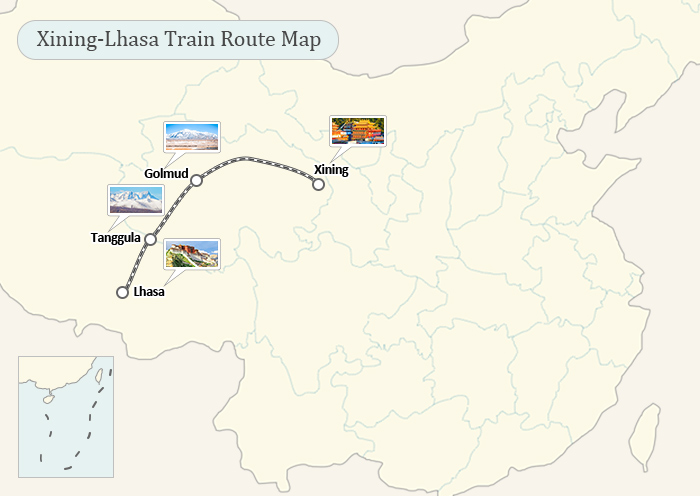

Xining to Lhasa Train
The train journey starts from Xining and concludes in Lhasa, following the original section of the Qinghai-Tibet Railway. Along the way, it passes through stations such as Delingha, Golmud, Anduo, and Nagqu.
China Tibet Railway
The China-Tibet Railway connects the Qinghai-Tibet Railway with major cities in China! It takes approximately 20-53 hours, about 1-2 days, to travel from cities like Beijing, Shanghai, Guangzhou, Chengdu, and Chongqing to Lhasa. The route also passes through important cities such as Xi'an, Lanzhou, Wuhan, and Changsha.
The train journey from Guangzhou to Lhasa is the longest route of the China Tibet Railway, taking around 53 hours.
Extension of Tibet Railway
Lhasa to Shigatse Railway: This railway allows you to cross 253 kilometers from Lhasa to Shigatse, the second-largest city in Tibet, in just 2.5 hours. It provides a shorter way to visit attractions like the Tashilhunpo Monastery and even facilitates travel to the base camp of Mount Everest. This project is also part of the Xinjiang-Tibet Railway.
Lhasa to Nyingchi Railway: This railway, which commenced operations in 2021, transports you from Lhasa to Nyingchi, the eastern gem of Tibet, in approximately 3.5 hours. Covering a distance of 435 kilometers, the train journey from Lhasa to Nyingchi offers a convenient way to explore the region.
Qinghai Tibet Railway (Tibet Train) Experience & Highlights
The completion of the Qinghai Tibet Railway has made it a dream for travelers from all over the world to embark on a journey to Tibet aboard the Qinghai Tibet train. The unique design of the train ensures a comfortable and enjoyable travel experience for passengers. Moreover, the unparalleled scenery outside the train window has always been a captivating aspect of traveling through Tibet by train.
The section of the Qinghai Tibet Railway from Golmud to Lhasa is a single-track railway that seamlessly connects between tracks. This means that you won't even hear the clicking sound when the train switches tracks.
Life Onboard
Taking a Tibet train journey is truly an unforgettable experience that will stay with you for a lifetime. The long-distance pressurized trains, specifically designed to withstand extreme altitudes, make this journey unlike any other train travel you've ever experienced.
During the at least 20-hour journey on the Tibet train, what facilities does the Qinghai Tibet train provide to enhance your onboard experience?
Qinghai-Tibet Railway (Tibet Train) Food Supply
The Qinghai Tibet train provides passengers with a variety of menu options. You can purchase snacks, beverages, and even boxed meals from the mobile food carts. If you prefer a more authentic dining experience, you can visit the dining car, where you can savor a range of delicious Chinese dishes. The dining car offers a unique opportunity to enjoy your meal while taking in the breathtaking views outside the window.
To help passengers cope with altitude sickness, which can include symptoms such as headaches, dizziness, and shortness of breath, the Tibet train is equipped with a two-level oxygen supply system.
Qinghai-Tibet Railway Oxygen Supply and Altitude Sickness
The first level releases a low concentration of oxygen into the train car when the elevation reaches 3000 meters. If passengers still feel uncomfortable, they can use individual oxygen outlets to inhale a higher concentration of oxygen directly. All cabins and corridors have these outlets, and disposable oxygen masks are provided.
The first level releases a low concentration of oxygen into the train cars when the train departs from Xining. If passengers still feel uncomfortable, they can use individual oxygen outlets to directly inhale a higher concentration of oxygen. These outlets are available in all cabins and corridors, and disposable oxygen tubes are provided.
In addition, there are doctors on board the Tibet train to handle emergency medical situations, ensuring a safe and worry-free Tibet train journey for you.
Qinghai-Tibet Railway Restrooms
The Tibet trains have both western-style and squat toilets. The bathrooms are regularly cleaned and maintained in a hygienic condition, ensuring a comfortable journey for all passengers. There are also sinks for washing up, mirrors, and a small counter space for personal items.
Importantly, it's advisable to bring your own toilet paper, as it's not always supplied in the bathrooms.
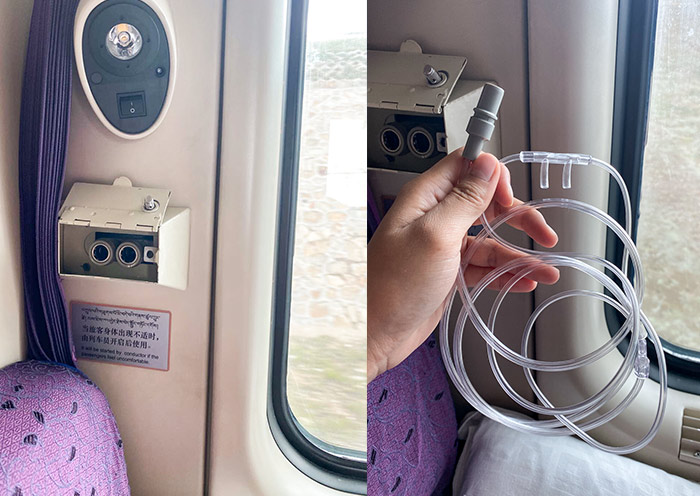

Scenery along the Qinghai Tibet Railway
From Xining to Golmud: Qinghai Lake & Mt. Yuzhu
Travel alongside largest saltwater lake in China, Qinghai Lake(青海湖), and enjoy the distant view of the majestic Mt. Yuzhu(玉珠峰) in the Kunlun range. This leg of the journey offers a dual delight for the senses and the soul.
From Golmud to Tuotuo River: Kekexili
Step onto the plateau from Golmud, and prepare to be amazed by the panoramic views of the Qinghai-Tibet Plateau. Traverse the Gobi from Golmud to the Hoh Xil(可可西里) nature reserve and if luck favors, spot the sprinting Tibetan antelopes.
From Tuotuo River to Nagqu:Tuotuo River, Cona Lake & Grassland
The journey is a sequence of highlights. Cross the headwaters of the Yangtze River at Tuotuo River(沱沱河), witnessing grand rivers merge and split. Then, a brief 10-minute drive along the shores of Lake Cona(措那湖) sets the stage for the endless grassland vistas of Nagqu, where herders and their livestock dot the vast landscape.
From Nagqu to Lhasa
The continuous Nyenchen Tanglha mountains(念青唐古拉山) have become an iconic sight along the Qinghai-Tibet Railway. As Lhasa draws near, the sight of the Potala Palace, a symbol of Tibetan culture, signifies your arrival at the spiritual heart of Tibet.
If your travel goal is to admire the enchanting scenery along the Qinghai-Tibet Railway, consider boarding the Shanghai to Lhasa train (Z164/165), Guangzhou to Lhasa train (Z265), or Xining to Lhasa train (Z8991). By choosing a train that departs from Xining later in the day, you will have more time to appreciate the breathtaking views of Kekexili, Tuotuo River, Lake Cuo Na, and the grasslands of northern Tibet without missing out due to darkness. That's the secret - opt for a Tibet train that departs from Xining later in the day!
Looking to explore the stunning landscapes of the Qinghai-Tibet Railway? Check out the ultimate guide to best time to take a train to Tibet.


Qinghai Tibet Railway Ticket Price
| Train Number | Departure Station | Duration | Hard Seat (yuan) | Hard Sleeper (yuan) | Soft Sleeper (yuan) |
|---|---|---|---|---|---|
| Z21 | Beijing West | 39h28m | 360 | 720 | 1144 |
| Z164 | Shanghai | 44h32m | 402.5 | 793.5 | 1262.5 |
| Z265 | Guangzhou | 52h57m | 447 | 865 | 1468 |
| Z8991 | Xining | 19h49m | 224 | 495 | 781 |
| Z322 | Chengdu West | 33h45m | 302.5 | 627.5 | 997.5 |
| Z223 | Chongqing North | 34h28m | 302.5 | 627.5 | 997.5 |
Please note that all schedules are subject to change. Contact your travel agency to map out your Tibet Train Tour.
Ticket prices for the Qinghai-Tibet Railway vary depending on the route, with prices ranging from 224 to 1468 yuan. Passengers can choose from three different seating options: hard seat, hard sleeper, and soft sleeper.
Hard Seat: This is the most economical choice. Seats are arranged in an open-plan carriage with a 3+2 configuration and can accommodate 98 people per carriage. The comfort level is basic and not recommended for long journeys.
Hard Sleeper: This option offers a balance between comfort and economy. Each carriage contains several compartments, with each compartment housing six bunks (two lower, two middle, and two upper bunks).
Soft Sleeper: This is a more comfortable and private option. Each compartment is enclosed and contains four bunks (two lower and two upper bunks). However, securing a soft sleeper ticket during peak season may be challenging.
As for the purchase of tickets for the Qinghai-Tibet Railway, you can buy your desired Tibet train tickets at the train station with your passport. Alternatively, you can also reserve your tickets online if you have a viable payment method such as Alipay or WeChat Pay. Tickets for the Tibet train are released 15 days in advance, so make sure to set a reminder to snag those tickets.
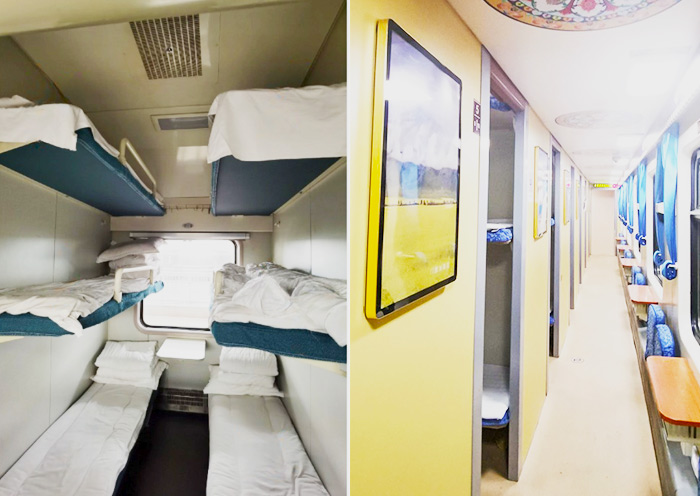

Take Tibet Train Tours with Asia Odyssey Travel
As a seasoned travel agency specializing in Tibet travel for over 10 years, Asia Odyssey Travel has established offices and local teams worldwide, including major Chinese cities conveniently connected to Lhasa, Tibet (Xizang), by train and flights. Expanding tour destinations in China provides a Panoramic Tibet Travel Experience with diverse optionsThat's why we have meticulously crafted Tibet Train Tours starting from various major Chinese cities, ensuring an immersive, all-inclusive journey with a wide range of choices.
You can opt for our Tibet Train Tour starting from Beijing, Chengdu, Shanghai, Xian, Xining, Chongqing, Hong Kong and more cities in China or even from Bhutan or Nepal!
There is no need to worry about booking train tickets to Tibet, language barriers, or anything you can think of, as we have you covered every step of the way! If you prefer to travel at your own pace Asia Odyssey Travel will always map out the Best Travel Plan for you, so you can simply hop on the train and start your Grand Tour of Tibet!

